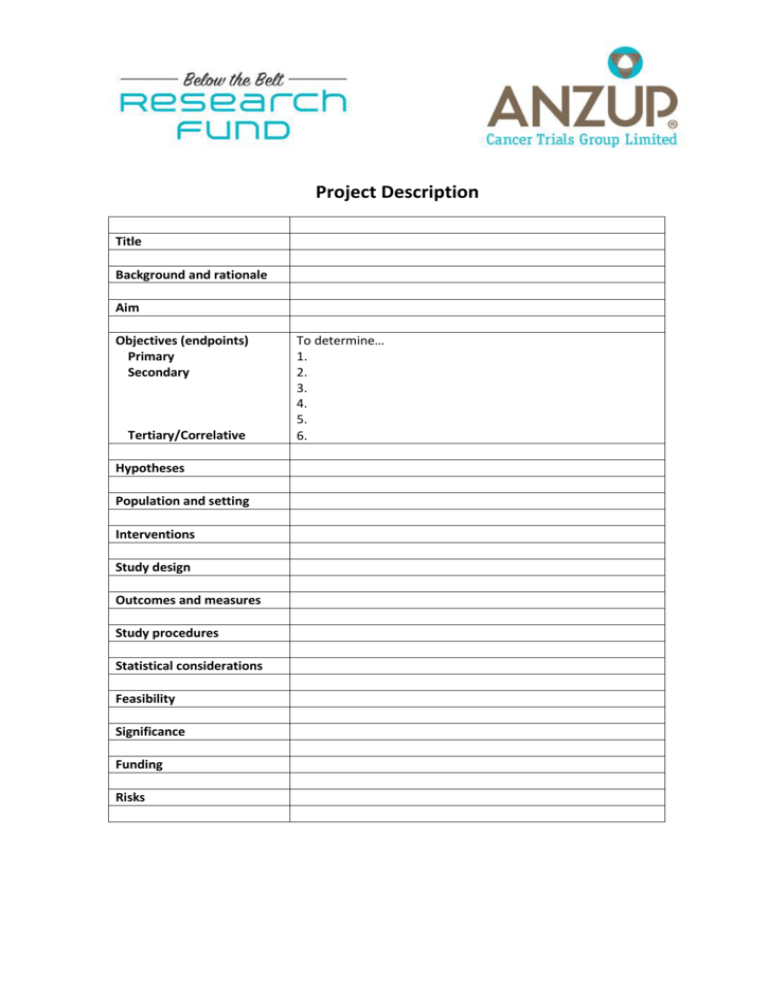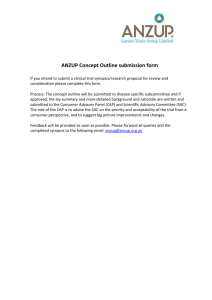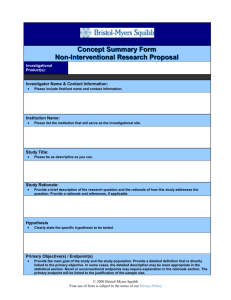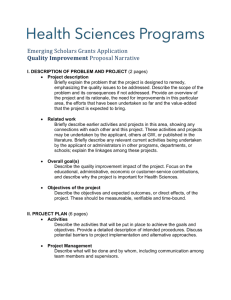Design and Analysis of Controlled Trials for Management of Pain
advertisement

Project Description Title Background and rationale Aim Objectives (endpoints) Primary Secondary Tertiary/Correlative Hypotheses Population and setting Interventions Study design Outcomes and measures Study procedures Statistical considerations Feasibility Significance Funding Risks To determine… 1. 2. 3. 4. 5. 6. Detailed background and rationale (1-2 pages including references) Other pertinent details (1-2 pages) You may find the below information helpful for completing the above Project Description. Developing Concept Outlines for proposed studies: Introduction The aim of this guide is to help clinical researchers turn good ideas into successful projects by providing a framework for writing a concept outline for a proposed study. A concept outline is a preliminary account of the plan for a project. The purpose of a concept outline is to provide a brief, clear summary that helps readers understand, discuss, refine and support (we hope) a proposed study. The key readers of an outline for a proposed study are potential investigators and peer-reviewers, for example: members of scientific advisory boards, grant review committees and institutional review boards. These readers are usually knowledgeable, busy and trying to answer two basic questions about a proposed study: “Should we support it?” and “Should it be changed?” An outline should quickly and clearly convey the information they need to answer these questions. Standard headings provide a useful structure and starting point for an outline. They help the writer include what is important, and the reader find it. Readers of a concept outline are appraising the proposed study. Typical criteria for appraisal include the importance of the problem, the potential impact of the intervention, scientific excellence and feasibility. Innovativeness and alignment with specific priorities may also be relevant. A concept outline also provides a useful basis for writing a protocol. The protocol will cover everything in the concept outline, much of it in more detail. In practice, the concept outline and protocol are often written together, and although this is sensible, it sometimes results in an outline with too much detail. A concept outline should give readers only the information needed for deciding whether to support a study. The information needed for doing a study should be left to the protocol. One page is the ideal length for a concept outline. Use both sides if you must. 1. Title The title should briefly and accurately describe the study design and the 3 components of a ‘wellbuilt clinical question’ advocated by proponents of evidence-based medicine. Study design is the most important criterion for determining the validity of a study. The 3 components of a well-built clinical question are the population, interventions, and outcomes. Each of these elements is discussed in more detail below. The title should also indicate that (if) the document is a proposal. 2. Background and rationale This section of the outline should cover the extent and scope of the clinical problem (why the area is worth researching), the rationale for the interventions, and the rationale for the study. Evidence supporting the importance of the problem is important. What is known about available interventions should also be summarized, along with possible areas for improvement. This naturally leads to the rationale(s) for the experimental treatment (and comparator). Listing the potential pros and cons of the study interventions highlights the importance of doing a randomised trial (if this is what is proposed). How the study will improve knowledge and practice should also be described. The more briefly this can be done, the better. 3. Aims, objectives and hypotheses Aims are general. Objectives are specific. The aims define what a study will determine in general terms. The objectives define what a study will determine in specific terms. There should be a single, primary objective. All other objectives are secondary (or tertiary). Hypotheses are the specific predictions a study is designed to test. The primary objective, most secondary objectives, and some tertiary objectives should each have a corresponding hypothesis. The primary and secondary objectives of a study usually relate to the outcomes of interest and therefore can usually be worded to include the relevant endpoint. Correlative and/or exploratory aspects of an intervention study are probably best incorporated as tertiary objectives. 4. Study Design One sentence is usually sufficient to summarize the important aspects of a study’s design. It should cover the phase, blinding, and any other distinctive features of trial design. However, brevity belies the importance of study design, which is the most important aspect for determining the validity of a study. The purpose of a clinical trial is to answer specific questions about the effects of a treatment. The design of a trial determines what sorts of question it is able to answer. The first methodological question reviewers ask is whether the study design is suitable for answering the study question. Phase 1 and 2 trials are designed to guide research. Phase 1 trials are about feasibility and toxicity and determine whether further research is possible. Phase 2 trials are about activity and toxicity and determine whether further research is worthwhile. Phase 3 trials are designed to guide clinical practice and are about direct measures of benefits and harms to patients and determine whether a new approach should be adopted in practice. 5. Population and Setting The target population and setting should be described briefly, along with the most important inclusion and exclusion criteria. The target population defines the group suitable for the intervention. The setting defines the environment in which subjects will be recruited and treated. The inclusion and exclusion criteria specify the characteristics of people who may and may not participate in a study. An accurate description helps reviewers judge a study’s generalisability and applicability. 6. Intervention(s) Interventions are actions taken to improve a condition or situation. Their nature and how they will be administered should be briefly described here. For drugs, this includes dose(s), duration(s), important allowed and prohibited concomitants, and rescue interventions. Placebos, active controls and non-drug interventions should also be outlined in sufficient detail for reviewers to understand what they will involve. If best supportive care is to be used, then its nature and details should be described briefly. 7. Outcomes, measures and endpoints This section of the outline summarizes the effects of interest and how they will be measured, quantified and compared. It is useful to distinguish between outcomes, outcome measures, endpoints, and measures of effect when designing and planning a study. However, these terms are frequently used loosely and interchangeably so a flexible approach is necessary. Outcomes are the consequences of interest that may occur in response to an intervention. There are usually many outcomes of interest in a clinical trial, but the larger the number of outcomes examined, the greater the likelihood of spurious findings. Outcome measures are the tools used to quantify the outcome of interest, for example RECIST criteria for objective tumour response, or a numeric rating scale for pain intensity. A validated outcome measure is one that has been shown to reliably measure what it is supposed to measure. Strictly speaking, the term ‘endpoint’ refers to a health event or observation that leads to the completion or termination of follow-up for an individual in a study. These can include positive or negative effects of treatment, disease, or other factors. Death, relief of symptoms, withdrawal of treatment, a specific adverse event, or a specified time point are examples. However, it is probably better to use endpoint to denote the observation or summary statistic used to express the overall effect of a treatment on an individual. The term measure of effect refers to how groups of individuals will be summarized (and compared), for example response rate (difference), progression free survival distribution (hazard ratio, logrank test). A positive finding on the single primary outcome, measure, endpoint, measure of effect, objective and hypothesis, all selected before the data were examined, provides much stronger support than the same finding selected from a multitude after they were examined. The primary outcome (endpoint) should be the most important and compelling one: the outcome (endpoint) you would (and should) choose to believe if there are conflicting results. The primary outcome, measure, endpoint, measure of effect, objective and hypothesis should correspond with one another, and should be the basis of the sample size calculations. If a study’s endpoints are clearly incorporated in its objectives, then this section can be used to include important details of assessment methods, measurement scales, definitions. 8. Study Procedures This section should briefly summarize how subjects are recruited and followed. One approach is to describe what happens to subjects, another is to summarize the schedule of assessments from the protocol. The trick is to provide a broad outline and avoid excessive detail. The outline should briefly describe what important things happen when; the details belong in the protocol. The timing of assessments is important. It should account for the likely trajectory of the disease and its consequences with and without treatment. Assessments should be frequent enough to detect important changes, but not so frequent that they annoy participants. Assessments should continue long enough to detect important changes, but not so long that extraneous factors obscure the treatment effects. It is worth considering whether the aim of the study is to discover if a treatment works, or how long it works. End of study visits and ratings are specially important if subjects are likely to go ‘off-study’ because of their worsening condition. Otherwise, the results will give a falsely optimistic view of their experience. 9. Statistical considerations The sample size, analysis plan, study duration and tactics for dealing with multiple outcomes, missing data, and attrition should be described briefly in this section. Simple, valid methods are available for the vast majority of questions. Early involvement of an experienced statistician is vital. The sentence on sample size should specify the number of subjects needed to detect the minimum clinically important difference on the measure of effect for the primary endpoint with a specified test, level of confidence or significance, and power. The key decision is how small an effect warrants declaring the results ‘significant’. The analysis plan should specify analyses that are by ‘intention to treat’ and justify those that are not. Cancer research studies always include multiple outcomes, endpoints, attrition and missing data; all of which increase the risk of spurious results. The analysis plan should specify methods for dealing with these problems. 10. Feasibility Feasibility, especially of recruitment, is a key consideration for reviewers. This section should outline the proposed sources of subjects and estimated recruitment rates. If the success of the study depends on getting treatments, reagents or other materials, then this should also be addressed briefly. 11. Significance Explain what makes the study important and why it will be worthy of attention. What difference will doing this study make; in other words, what are the implications (likely consequences) of its findings (positive or negative)? 12. Funding List potential sources of funding and their timing (application deadlines, decision dates and grant durations). List the arguments most likely to persuade potential funders. List strategies for improving the likelihood that funding applications will be successful. 13. Risks What are the main threats to starting and completing the study? What are possible adverse consequences of doing the study? What can be done to mitigate these hazards?





